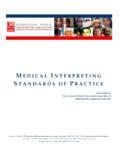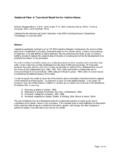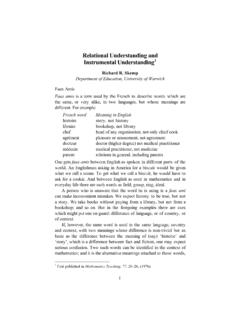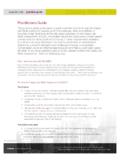Transcription of WARNING: This paper was published in ‘Proceedings 2012 - 44
1 IMPLEMENTING BEST PRACTICES OF METAL ACCOUNTING AT THE STRATHCONA MILL *Luc Lachance, Donald Leroux and Simon Gari py Algosys Inc. Parc technologique 2750, Einstein #120 Qu bec (Qu bec) Canada G1P 4R1 (*Corresponding author: Hayley Halsall-Whitney and Asim Tuzun Xstrata Nickel Canada Strathcona mill 85 Regional Road Onaping, Ontario Canada P0M 2R0 ABSTRACT The importance of coherent material balance results has long been recognized by mining and metallurgical companies. Although this is still true nowadays, various stakeholders are increasingly concerned about the origin and the accuracy of the reported numbers. The last decade has shown that most metallurgical accounting concerns can be addressed by making two important changes to plant performance monitoring practices. First, introducing data redundancy into the metal balance procedure allows the estimation of measurement errors.)
2 Second, the migration from spreadsheet-based to relational database based systems brings transparency, data integrity, traceability and auditability into metallurgical accounting. Relational databases also facilitate the production of reports that metallurgical accountants must issue routinely. Recognizing the caveats of the spreadsheet-based metal accounting method they had been applying for years, Strathcona decided to switch to a commercial relational database system in 2008. For the most part, the migration was seamless. Some challenges were raised but they could all be overcome and outweighed by benefits gained from day-to-day utilization of the system. KEYWORDS Metallurgical accounting, Flotation, Best practices, Technology migration project WARNING: This paper was published in Proceedings 2012 - 44th Annual Meeting of the Canadian Mineral Processors of which the copyrights are owned by the Canadian Institute of Mining, Metallurgy and Petroleum (CIM).
3 Electronic and hard copies of the proceedings can be ordered at INTRODUCTION Metal accounting (Morrison, 2008) has always been essential to high-quality corporate governance of mining and metallurgical companies. Although the importance of coherent material balance results has long been recognized, various stakeholders are increasingly inquisitive about how the reported numbers were obtained and how much accuracy can be attributed to them. This accrued scrutiny is obviously no stranger to the corporate governance tightening that happened through the years in response to outrageous accounting scandals. It is also in continuity with securities laws (such as NI-43-101 in Canada) that were passed to protect the public from other market fraud. Recognizing the importance of spotless metal accounting in their reports to the public, a group of global mining companies gave AMIRA International the mandate of developing a set of rigorous yet practical metal accounting guidelines for the mining and metallurgical industry.
4 The AMIRA P754 project was launched in 2004 and the first version of the resulting Code of Practice was released the following year. Since then, the Code was reviewed twice and revised releases were issued (Anonymous, 2007). While some parts of these guidelines are in continuity with current commonplace practices, other parts recommend changes to inherited practices that may be significant. For example, they highlight the importance of data redundancy (Lachance & Flament, 2011) which in many operations is either already available but unexploited or achievable with reasonable efforts. These guidelines also stress the importance of state-of-the-art metal accounting systems, such as those based on relational databases, which are secure and entirely auditable by a Qualified Person. Because most spreadsheet software packages allow data and formulae to be modified at any time, without a trace and anonymously, they do not meet these requirements.
5 The main goal of this paper is to describe the implementation of new metallurgical accounting practices at the Strathcona mill and to compare them to the AMIRA P754 Code of Practice. Main issues encountered on the road to implementation are raised along with applied solutions and the benefits gained from day-to-day applications of the new practices. This case study will also be analyzed bearing in mind the results of a recent survey (Gaylard, Morrison, Randolph, Wortley, & Beck, 2009) of AMIRA P754 project sponsors about their current use of the guidelines. The paper begins with a short description of the metallurgical accounting challenges that the Strathcona mill staff face on a daily basis. It is followed by a summary of the Code of Practice which is essentially the listing of the ten basic principles of metallurgical accounting put forward by AMIRA. The list is then used as a basis for analyzing and discussing the Strathcona mill case.
6 METALLURGICAL ACCOUNTING AT THE STRATHCONA MILL The Strathcona flotation plant (see Figure 1) is part the Sudbury operations of Xstrata Nickel which also include the Nickel Rim South mine, the Fraser mine and the Sudbury nickel smelter. Strathcona is currently a custom milling operation and processes ores from Xstrata and non-Xstrata mining sites. Its two main products are a nickel-copper and a copper concentrates. Given that the plant must report coherent metal production balances to different customers (including their own management) and that blending between feed sources may at times be required to maximize plant feed rate, metal accounting at Strathcona is somewhat more challenging than at a typical single-feed flotation plant. Figure 1 Simplified flowsheet of the Strathcona flotation plant THE TEN PRINCIPLES OF BEST METALLURGICAL ACCOUNTING PRACTICES (BMAP) In order to qualify the metal accounting practices of the Strathcona mill, the ten principles of metal accounting put forward by AMIRA are used as a reference.
7 These principles were defined by the P754 project team through the development of the Code of Practice for Metal Accounting (AMIRA 2007). In a nutshell, they represent the requirements for a metal accounting system to be accurate, credible, practical, reliable, transparent and auditable. The principles are meant to be applicable throughout the mining and metallurgical industry, from precious to base metals and from mine to product. Table 1 is a slightly re-arranged list of metallurgical accounting principles that AMIRA had originally put together. Essentially, it highlights the criteria that each principle addresses specifically and it groups them into two categories. While five principles deal with data quality, five specifically describe the characteristics of a state-of-the-art metal accounting system. Table 1 Edited list of the ten AMIRA principles of BMAP Category Criteria # Details Data Measurement accuracy 10 The metal accounting system must ensure that every effort is made to identify any bias that may occur, as rapidly as possible and eliminate or reduce to an acceptable level the source of bias from all measurement, sampling and analytical procedures, when the source is identified.
8 Targeted accuracy 8 Target accuracies for the mass measurements and the sampling and analyses must be identified for each input and output stream used for accounting purposes. The actual accuracies for metal recoveries, based on the actual measurement accuracies, as determined by statistical analysis of the raw data, achieved over a company s reporting period must be stated in the report to the company s audit committee. Should these show a bias that the company considers material to its results; the fact must be reported to shareholders. Data validation and redundancy 7 The system must generate sufficient data to allow for data verification, the handling of metal/commodity transfers, the reconciliation of metal/commodity balances, and the measurement of accuracies and error detection, which should not show any consistent bias. Measurement and computational procedures must be free of a defined critical level of bias.
9 Provisional data 6 Where provisional data has to be used to meet reporting deadlines, such as at month ends when analytical turn-around times could prevent the prompt issuing of the monthly report, clear procedures and levels of authorisation for the subsequent replacement of the provisional data with actual data must be defined. Where rogue data is detected, such as incorrect data transfer or identified malfunction of equipment, the procedures to be followed together with the levels of authorisation must be in place. In-process inventory 9 In-process inventory figures must be verified by physical stock-takes at prescribed intervals, at least annually, and procedures and authority levels for stock adjustments and the treatment of unaccounted losses or gains must be clearly defined. System Completeness and integration 1 The metal accounting system must be based on accurate measurements of mass and metal content.
10 It must be based on a full check in-check out system using the best practices as defined in this code, to produce an on-going metal/commodity balance for the operation. The system must be integrated with management information systems, providing a one-way transfer of information to these systems as required. Timeliness 5 Accounting results must be made available timeously, to meet operational reporting needs, including the provision of information for other management information systems, and to facilitate corrective action or investigation. A detailed report must be issued on each investigation, together with management s response to rectify the problem. When completed, the plan and resulting action must be signed-off by the Qualified Person. Transparency 2 The system must be consistent and transparent and the source of all input data to the system must be clear and understood by all users of the system.






